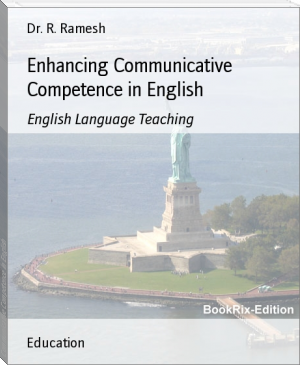Cognitive Development in English Language Teaching, Rajesh Lane [best motivational books for students txt] 📗

- Author: Rajesh Lane
Book online «Cognitive Development in English Language Teaching, Rajesh Lane [best motivational books for students txt] 📗». Author Rajesh Lane
The teacher’s The student’s
Syllabus Syllabus
[ Syll.B ] [ Syll.C ]
You can have several Syllabus D
The real syllabus
The classroom syllabus
(“Types of syllabus and materials, Block-II”, 32)
Syllabus - A may refer to a document for speaking skill that has to be taught. The teacher decides to teach this skill by allowing the learners to speak on certain emergent problems of the world. This is the teacher’s syllabus or syllabus-B. Students X and Y Responds to the teacher without interesting. Instead this student talks an ongoing foot ball match. This is Syllabus-C; or the individual syllabus. There can be many students syllabus as C1, C2, C3, C4, C5, C6, etc. The general interaction between students and teacher produces the classroom – syllabus or syllabus-D. If the whole class prefers to speak on football match, the interest in the classroom task would be very high.
At the present, decisions are made by educational system and teachers alone. This has been confronted by many theoreticians.
For Breen, what distinguishes the process syllabus is, the way in which it organized. He emphasizes the learner’s participation in the decision making process.
According to Brian Kenny; “ In a language development class, it is not always necessary for the teacher to be introducing the subject – matter, learners can introduce the same on their own. The content of this introduction will form the raw material of the educative process in which it will be submitted to analysis, verification, criticism, comparisons and judgments”. (Language use Language Teaching and The Curriculum, 259).
For a favourable classroom decision; the interaction should be taken be between the learner and teacher. Allwright proposed this co-operative management of the syllabus. “In co-operative management of the syllabus the decision-making process is shared with teachers and students who work together as partners in the management of language learning”. (Language use Language Teaching and The Curriculum, 356).
Lynn Stein endorses cooperative learning classroom – centred research and suggests as follows:
In an effect to involve my students in their learning, and to observe and learn from them, co-operative management has become as an integral and important component in my teaching. Results indicate that language learners can and should, to the maximum degree possible, be involved in the decisions which affect their learning . (Language use Language Teaching and The Curriculum, 356).
As a second language learner, s/he should be allowed to do the classroom activities. Present teaching system is basically teacher – directed to overcome fear and misunderstanding, learner-directed interaction should be made.
“Pica through his research found that teacher-directed participation produced relatively less modified interaction than the learner-directed groups”.
(Language use Language Teaching and The Curriculum, 324). He also opines that unless the learner is allowed to speak s/he cannot speak fluently. So the classroom activities should be shared with learners.
Before doing the class-room activities the learner’s needs should be taken into account. Ronald V. White, classified needs into two sorts: “Firstly, to acquire a knowledge of the second language system and culture, Secondly to acquire the ability to perform with some degree of fluency in the second language, that is, to develop communicative competence” (The ELT Curriculam,110 ). Classroom second language acquisition is supported by many experts, for example ( Long and Porter, 1985; Pica and Doughty 1985; Porter 1986; Rulon and Mc Creary 1986; Varonis and Gass, 1985 ) as teachers can enable language acquitision in classroom settings.
In the classroom second language acquisition, context plays a vital role in making learner’s communicative activities. Context includes various factors in framing the second language acquisition situation. The classroom teacher plays the role of a facilitator.
Aida Walqui, points out the contextual factors in second language acquisition as:
Language ( Native language proficiency, knowledge of the second language, Dialect and register, language attitudes ); the learner ( Diverse needs, Diverse goals, Peer groups, Role models, home support);Acquisition process ( acquisition styles, classroom interaction ); his research concludes that the social and cultural contexts have a tremendous impact on second language acquisition (“Contextual Factors in Second Language acquisition”,http://www.Google.com).
The Researcher found from his interaction with the students that the contextual factors include the following items;
(a) Learner’s age
(b) Learner’s psychology
(c) Learner’s environment ( cultural, socio-economic,
linguistic status )
(d) Learner’s field of interest and
(e) Learner’s language proficiency (Strengths and Weaknesses)
These contextual factors influence the communicative process of the learners. On the basis of the contextual factors, the syllabus should be framed for their maximum understanding.
At U . G level the communicative proficiency and their creativity should be developed. To improve the communicative proficiency the meaning-focused fluency-based communicative activities should be practiced. Here the form and accuracy of grammar is not important. Kelly and Titone have shown, how there has been what Titone describes as “ a swing of a pendulum “ between two basic positions held in ELT over the years. They are:
[ i ]
Syllabus Syllabus
[ Syll.B ] [ Syll.C ]
You can have several Syllabus D
The real syllabus
The classroom syllabus
(“Types of syllabus and materials, Block-II”, 32)
Syllabus - A may refer to a document for speaking skill that has to be taught. The teacher decides to teach this skill by allowing the learners to speak on certain emergent problems of the world. This is the teacher’s syllabus or syllabus-B. Students X and Y Responds to the teacher without interesting. Instead this student talks an ongoing foot ball match. This is Syllabus-C; or the individual syllabus. There can be many students syllabus as C1, C2, C3, C4, C5, C6, etc. The general interaction between students and teacher produces the classroom – syllabus or syllabus-D. If the whole class prefers to speak on football match, the interest in the classroom task would be very high.
At the present, decisions are made by educational system and teachers alone. This has been confronted by many theoreticians.
For Breen, what distinguishes the process syllabus is, the way in which it organized. He emphasizes the learner’s participation in the decision making process.
According to Brian Kenny; “ In a language development class, it is not always necessary for the teacher to be introducing the subject – matter, learners can introduce the same on their own. The content of this introduction will form the raw material of the educative process in which it will be submitted to analysis, verification, criticism, comparisons and judgments”. (Language use Language Teaching and The Curriculum, 259).
For a favourable classroom decision; the interaction should be taken be between the learner and teacher. Allwright proposed this co-operative management of the syllabus. “In co-operative management of the syllabus the decision-making process is shared with teachers and students who work together as partners in the management of language learning”. (Language use Language Teaching and The Curriculum, 356).
Lynn Stein endorses cooperative learning classroom – centred research and suggests as follows:
In an effect to involve my students in their learning, and to observe and learn from them, co-operative management has become as an integral and important component in my teaching. Results indicate that language learners can and should, to the maximum degree possible, be involved in the decisions which affect their learning . (Language use Language Teaching and The Curriculum, 356).
As a second language learner, s/he should be allowed to do the classroom activities. Present teaching system is basically teacher – directed to overcome fear and misunderstanding, learner-directed interaction should be made.
“Pica through his research found that teacher-directed participation produced relatively less modified interaction than the learner-directed groups”.
(Language use Language Teaching and The Curriculum, 324). He also opines that unless the learner is allowed to speak s/he cannot speak fluently. So the classroom activities should be shared with learners.
Before doing the class-room activities the learner’s needs should be taken into account. Ronald V. White, classified needs into two sorts: “Firstly, to acquire a knowledge of the second language system and culture, Secondly to acquire the ability to perform with some degree of fluency in the second language, that is, to develop communicative competence” (The ELT Curriculam,110 ). Classroom second language acquisition is supported by many experts, for example ( Long and Porter, 1985; Pica and Doughty 1985; Porter 1986; Rulon and Mc Creary 1986; Varonis and Gass, 1985 ) as teachers can enable language acquitision in classroom settings.
In the classroom second language acquisition, context plays a vital role in making learner’s communicative activities. Context includes various factors in framing the second language acquisition situation. The classroom teacher plays the role of a facilitator.
Aida Walqui, points out the contextual factors in second language acquisition as:
Language ( Native language proficiency, knowledge of the second language, Dialect and register, language attitudes ); the learner ( Diverse needs, Diverse goals, Peer groups, Role models, home support);Acquisition process ( acquisition styles, classroom interaction ); his research concludes that the social and cultural contexts have a tremendous impact on second language acquisition (“Contextual Factors in Second Language acquisition”,http://www.Google.com).
The Researcher found from his interaction with the students that the contextual factors include the following items;
(a) Learner’s age
(b) Learner’s psychology
(c) Learner’s environment ( cultural, socio-economic,
linguistic status )
(d) Learner’s field of interest and
(e) Learner’s language proficiency (Strengths and Weaknesses)
These contextual factors influence the communicative process of the learners. On the basis of the contextual factors, the syllabus should be framed for their maximum understanding.
At U . G level the communicative proficiency and their creativity should be developed. To improve the communicative proficiency the meaning-focused fluency-based communicative activities should be practiced. Here the form and accuracy of grammar is not important. Kelly and Titone have shown, how there has been what Titone describes as “ a swing of a pendulum “ between two basic positions held in ELT over the years. They are:
[ i ]
Free e-book «Cognitive Development in English Language Teaching, Rajesh Lane [best motivational books for students txt] 📗» - read online now
Similar e-books:





Comments (0)